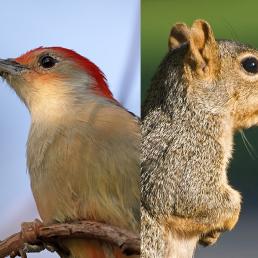

Join BirdNote tomorrow, November 30th!
Illustrator David Sibley and actor H. Jon Benjamin will face off in the bird illustration battle of the century during BirdNote's Year-end Celebration and Auction!
The Northern Shrike breeds in the tundra and taiga of the north, but migrates south into the lower 48 for the winter. It has a pleasing and rhythmical song, which it sings even in winter. But its song belies a rather bloodthirsty feeding habit. The shrike impales its prey on sharp thorns or barbed wire, where it can pull it apart and consume it.
BirdNote®
The Butcherbird
Adapted from a script by Frances Wood
This is BirdNote.
[Song of Northern Shrike]
The Northern Shrike is a robin-sized, pale gray bird with black wings and a jet-black mask. But don’t let this quirky, metallic song fool you. It’s the call of a bloodthirsty killer.
[More song]
The Northern Shrike breeds in the tundra and taiga of the north, but migrates south for the winter, perching on the tops of tall trees and shrubs to look for prey.
The shrike is a meat-eater, diving down from its tall perches to catch insects, small mammals, and even other birds. It’s such a fierce hunter, it’ll often take down prey bigger than itself. Then it carries its meal over to a thorny bush, or maybe to a barbed wire fence, and impales it, sticking its meat on a hook, before slowly tearing it apart — the way we might eat a rotisserie chicken.
That’s why shrikes are also known by another name, the “butcherbirds.”
If you want to see a Northern Shrike in action, head to open country in Canada and the northern U.S. And listen for the “butcherbird’s” innocent-sounding song.
[Song of the Northern Shrike]
For BirdNote, I’m Ashley Ahearn.
###
Senior Producer: Mark Bramhill
Producer: Sam Johnson
Managing Editor: Jazzi Johnson
Content Director: Jonese Franklin
Narrator: Ashley Ahearn
Song of the Northern Shrike recorded by Kevin J. Colver. Used with permission. Eastern Washington ambient recorded by C. Peterson.
BirdNote’s theme was composed and played by Nancy Rumbel and John Kessler.
© 2019 BirdNote November 2019 / December 2022/2024
ID# NSHR-01b-2019-11-4 NSHR-01b






